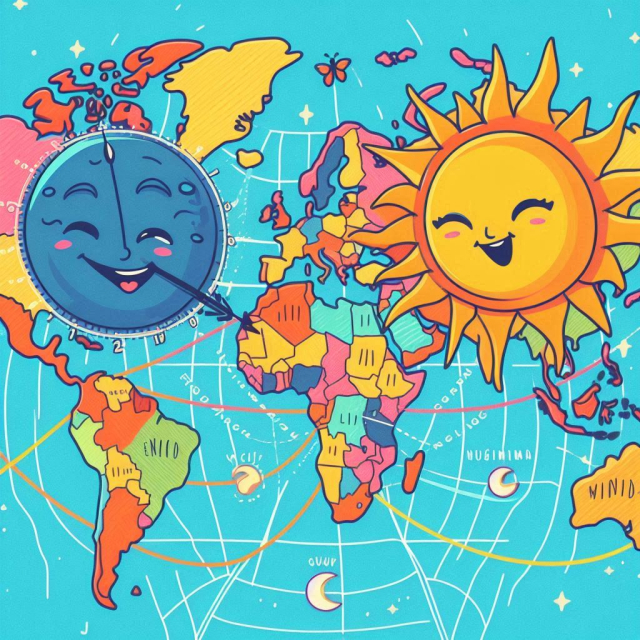Time zones are a human creation designed to coordinate the time of day with the position of the sun in the sky, thus optimizing human activities across different regions of the world. This article will explore the origin of time zones, their implementation and operation, and their relevance in the modern globalized context.
Origin and Development of Time Zones.
Before the invention of time zones, each locality had its own solar time based on the position of the sun in the sky. This practice worked well in an era where travel and communication were limited. However, with the advent of railroads and telegraphs in the 19th century, the need for a standardized time system became apparent.
In 1879, Canadian Sir Sandford Fleming proposed the idea of dividing the world into 24 time zones, each spanning 15 degrees of longitude and representing one hour of the day. This proposal was accepted at the International Meridian Conference held in Washington DC in 1884, where the Greenwich Meridian was also established as the principal meridian (0° longitude).
Operation of Time Zones.
Time zones divide the Earth into 24 segments of 15 degrees longitude each. Each segment corresponds to one hour of solar time, starting at Greenwich Mean Time (GMT, now known as UTC - Coordinated Universal Time). Time zones are numbered from UTC-12 to UTC+14, and each hour is added or subtracted relative to UTC.
Time zones allow the hours of day to be approximately synchronized with the position of the sun in the sky. For example, when it is noon in a time zone, the sun is approximately at its highest point in the sky.
The Relevance of Time Zones in the Modern World.
Global Coordination.
In today's globalized world, time zones are crucial for the coordination of international activities. Companies operating in multiple countries need to synchronize meetings, calls and financial transactions. Time zones allow for efficient planning and reduce the possibility of misunderstandings.
Travel and Transportation.
For the travel and transportation industry, time zones are essential. International flights, trains and shipping require precise timing to avoid delays and ensure connections go smoothly. Flight schedules are published in local time, and converting between time zones is a routine task for travelers.
Communications and Media.
The transmission of news and events in real time is based on the understanding of time zones. News organizations coordinate the delivery of content so that it reaches their audience at the right time. International sporting events, such as the Olympic Games, are carefully scheduled to maximize global viewership.
Technology and Information Systems.
Digital technology and information systems rely on time zones to timestamp data. Servers, email systems, and social networks use time zones to record and display the correct time of activities. Software developers must take time zone differences into account when creating global applications.
Challenges and Adaptations.
Despite their usefulness, time zones also present challenges. Regions that cross multiple time zones may experience logistical complications. For example, Russia spans 11 time zones, which complicates internal coordination.
Additionally, some countries adopt daylight saving time, setting their clocks forward one hour for part of the year. This introduces an additional layer of complexity, since not all countries apply daylight saving time, and those that do do not always apply it on the same dates.
Technological solutions.
To address these challenges, technological solutions have been developed. Global time management systems and time zone conversion applications are essential tools for businesses and individuals who need to work across multiple time zones. These tools allow efficient planning and reduce the margin of error.
The UTC and its Fundamental Role.
UTC (Coordinated Universal Time) is the basis of the time zone system. It is a time standard that is not subject to daylight saving time variations and is used by many computer and communication systems as a reference. UTC facilitates global synchronization and coordination.
Impact on society.
Psychological and Biological Effects.
Time zones and variations in weather, such as the change to daylight saving time, can affect the human circadian rhythm. Sleep disruption and exposure to sunlight at different times of the day can have impacts on health and well-being.
Economic and Social Equity.
The establishment of time zones can have economic and social implications. Areas at the extremes of a time zone may experience disadvantages in terms of productivity and quality of life. Timing policies should consider these factors to minimize disparities.
Specific Cases and Curiosities.
China and its Unique Time Zone.
China, despite its vast territorial extension, uses a single time zone (UTC+8) for the entire country. This policy unifies the time throughout the country, but also creates unusual situations, such as the difference in sunrise and sunset between the eastern and western regions of the country.
The International Date Line.
The International Date Line (IDL) is an imaginary line located near the 180° meridian. Crossing this line from west to east subtracts one day, and crossing it from east to west adds one day. The IDL ensures that the count of days remains correct as the Earth rotates.
Time zones are a fundamental invention that facilitates the organization and coordination of activities at a global level. From their origin in the 19th century to their application in the digital age, time zones have proven to be an invaluable tool for time synchronization. Despite the challenges and complications that may arise, technological solutions and the adoption of standards such as UTC allow the modern world to function efficiently and harmoniously.
In a world that never sleeps, understanding and proper use of time zones will continue to be essential for progress and global connectivity.
